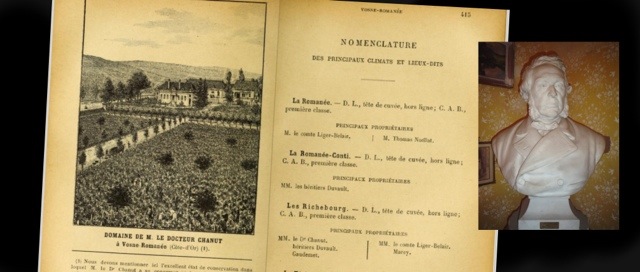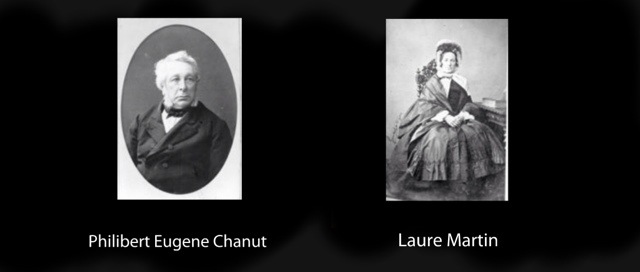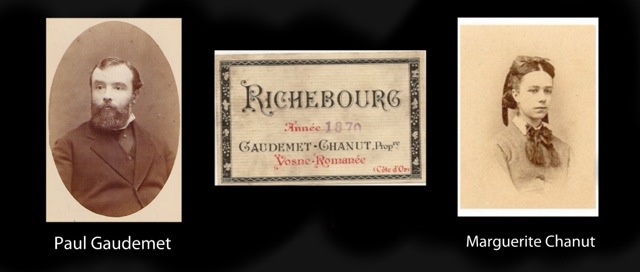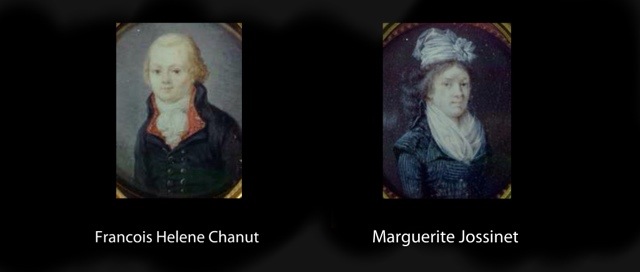If I say Domaine Chanut or Gaudemet-Chanut – do you then think of Burgundy or Vosne-Romanee – most likely not – nevertheless these domaines play a forgotten but important role in the history of Vosne-Romanee.
Domaine Chanut and later Gaudemet-Chanut was one of the most prominent domaines in Vosne-Romanee in the last part of the 19th century and the beginning of the 20th century – with vineyards in Richebourg, Romanee-Saint-Vivant, Grands Echezeaux and Echezeaux.

Furthermore Domaine Chanut owned the quite mythic La Goillotte in the center of Vosne-Romanee – now owned by Domaine de la Romanee-Conti and also acquired Domaine Frantin – the buildings now used by the current Domaine d’Eugenie.
The early history of Domaine Chanut
In the years before the revolution Francois Helene Chanut (1768 – 1825) came to Dijon to pursue fortune and luck. Francois was born in Forcalqier in the Provence Alpes and the younger son of a very old notary family – and he was indeed lucky, as he met a local girl – Marguerite Jossinet (1773 – 1849) – the daughter of Jean Philibert Jossinet, who was very wealthy Dijon grocer. In 1795 Francois Helene Chanut married Marguerite Jossinet – and this was the start of the Domaine Chanut era.
The origin of the Chanut estate was the Jossinet family in Dijon. The base of vineyards came from the wife of Jossinet – Anne Soucelier – who inherited a quite large portfolio of vineyards from her family in Flagey. Jean Philibert Jossinet also acquired Vosne-Romanee vineyards from seized religious properties during or just after the French revolution, and these holdings were combined into the Chanut estate in Vosne-Romanee.
Francois Helene Chanut had four children with his wife Marguerite Jossinet, where especially Philibert Eugene Chanut (1812 – 1885) and to some degree also Jean Joseph Chanut (1795 – 1869) played a big role in establishing and expanding the Domaine Chanut in Vosne Romanee.
Base line for the Domaine Chanut – Jules Lavalle 18551
It is always difficult to get a precise picture of the historic ownership of vineyards. To get a good baseline for the vineyard holding of Chanut estate we turn to Lavalle 1855, who recorded quite a lot for vineyard holdings for the Chanut family.
- Vosne-Romanee, Combe Brulee
- Vosne-Romanee, Les Suchots
- Vosne-Romanee, Aux Chaumes
- Grands Echezeaux
- Echezeaux En Orveau
- Echezeaux Les Achausses – now called Les Loächausses
- Echezeaux Les Rouges du Bas
- Echezeaux Les Beaux-Monts Bas
- Echezeaux Les Treux
- Echezeaux Les Quartieres de Nuits
- Flagey, Les Violettes
At this time the most prominent holdings were in Flagey Echezeaux, with plots in Grands Echezeaux and many of the different climates of the current Echezeaux vineyard. The large proprotion of Flagey vineyards most likely come from the Soucelier family heritage.
Domaine Dr. Chanut – the years or expansion
Philibert Eugene Chanut was a professor of medicin, doctor and surgeon in Dijon, but his interest in the wine business must have been quite strong as he continued to expand the domaine over the next 20 years.
In 1847 Dr. Philibert Eugene Chanut married Laure Martin (1824 – 1905), and the couple had two children – a daughter Marguerite Marie Chanut (1848 – 1925) and Dr. Jules Edouard Chanut (1852 – 1909). On the Jean Joseph Chanut side of the family the son Armand Jules Chanut (1842 – 1884) became the third key person in the next generation.

The expansion really seem to have started in 1860s where Philibert Eugene Chanut acquired plots in Richebourg and other prominent vineyards.
In December 1862 he acquired 1 ha 26 ares and 22 centiares of Les Richebourg from Morelet for a price of 50.000 F – a quite substantial plot of Les Richebourg7. Morelet or Morellet is not mentioned as a owner by Lavalle, and I will try to get some more informations about the plot and it’s origin.
In 1863 he furthermore bought Maison Frantin – 14 Rue de la Goillotte in Vosne Romanee – from the widow of Jean-Edme Frantin who died earlier that year. The price of the Frantin etate was 40.000 F, and included the estate buildings, the garden and a vineyard south of the estate with a area of 47,2 ares7 – most likely the Clos Frantin vineyard – recently renamed to Clos d’Eugenie. Given the price of 40.000 F it seems likely that the deal included more vineyards, as the price seems high compared to the price of the Richebourg plots acquired the year before.
These acquisitions were however not the only expansions of the domaine – and by 1892 the portfolio of vineyards had expanded quite dramatically and was covering most of the best terroirs in Vosne Romanee.
Danguy and Aubertin2 show the following vineyards under Chanut ownership in 1892
- Les Richebourg
- Les Richebourg (Gaudemet)
- Grands Echezeaux
- Echezeaux, Loachausses
- Echezeaux, Cruots ou Vignes Blanches
- Echezeaux, En Orveaux
- Echezeaux, Les Quartieres de Nuits
- Echezeaux, Treux
- Vosne Romanee, Les Beaux-Monts
- Vosne Romanee, Les Gaudichots
- Vosne Romanee, Les Malconsort
- Vosne Romanee, Les Suchots
- Vosne Romanee, Les Chaumes
- Vougeot, Les Petits Vougeot
- Vosne Romanee Maizieres basses, Maizieres hautes, Aux Communes, Dessus de la Riviere, Vigneux
The most prominent holdings were Richebourg, Grand Echezeaux, Echezeaux, Malconsort, Beaux-Monts and Gaudichots – and it is likely that they also had a plot of Romanee-Saint-Vivant at this stage – see more below.
It should be noted that there are two Chanut owners mentioned on Richebourg – Dr. Chanut and Gaudemet – this is a first indication of the division and demise of the domaine Chanut. In 1871 the daughter of Philibert Eugene Chanut – Marguerite Chanut – was married to Paul Gaudemet (1842 – 1920) a law professor and solicitor in Dijon, and this introduced the name Gaudemet into the Chanut family.
In 1885 Philibert Eugene Chanut passed away, and the estate was split between the two heirs over the next years. On the other side of the family Armand Jules Chanut died in 1884 – and left some of the estate to his girlfriend Charlotte Viennot and his part of the Vosne estates to his cousin Jules Edouard Chanut – who at that time lived in the Chateau La Goillotte. According to Gert Crum4 Dr. Jules Edouard Chanut owned La Goillotte and Clos Goillotte until 1907 where it was sold of – not by his heirs as Crum mention – but by Jules Edouard Chanut himself – he died two years later in 1909.
The Dr. Chanut houses and estates in Vosne Romanee
Domaine Chanut was owner of some of the historic buildings in Vosne Romanee – most notablely Chateau Goillotte and the Frantin winery in 14 rue Goillotte.
La Goillotte
The Goillotte – now owned by Domaine de la Romanee-Conti – was according to Danguy and Aubertin2 the main building in the Dr Chanut estate, and the son of Philibert Eugene Chanut – Jules Edouard Chanut stayed in this mansion until 1907 – this is confirmed by Gert Crum4. Danguy and Aubertin2 show a drawing of the beautiful estate with the beautiful garden, and the Clos Goillotte vineyard in front of the garden – with an alley of threes going through Clos Goilotte vineyard towards the mansion. La Goillotte was according to Crum4 sold in 1907 – but there is no information about the buyer.
The Maison Frantin
The Maison Frantin at 14 rue Goillotte was acquired in 1863 and was still a part of the Chanut estate when Philibert Chanut died in 1885. After the death of Philibert Eugene Chanut the Frantin estate was passed on to Juels Edouard Chanut – it’s however unclear when Frantin was sold of, but it’s likely it happened between 1905 – 1909 where Jules Edouard Chanut sold of all his properties.
The Frantin mansion and vinery is now owned by Domaine d’Eugenie who acquired this estate from Albert Bichot. Before Bichot acquired the buildings and the Frantin “brand” they were owned by Grivelet from Chambolle Musigny. I will try to uncover more information about the acquisition and sale of the Frantin estate.
The demise of Domaine Dr. Chanut
When Philibert Eugene Chanut passed away in 1885, he left the holdings to his two children, Jules Edouard Chanut and Marguerite Chanut. The property of Jules Edouard Chanut also included the estates and vineyards he got from his cousin Armand Jules Chanut.
Some years after the father’s death – Jules Edouard Chanut began to sell of his properties – and between 1905 and 1907 his quite vast holdings of vineyards were sold of.
It’s currently somewhat unclear how and when the vineyards were sold of, but it’s likely that the Frantin estate was sold of with some vineyards – either directly to Grivelet or via another buyer to Grivelet who most likely was the owner of Frantin in 1920 – Rodier 3 mention Grivelet as owner on Les Verroilles ou Richebourg. It’s also likely that some vineyards were sold of to the Charles Vienot estate, but there is no documentation to support this at this stage. Finally it’s likely that some vineyards were sold to Domaine Charles Noellat who was managing the Chanut estate in last years.
Gaudemet-Chanut – the end of the Chanut era
After the death of Philibert Eugene Chanut in 1885 and the following proces the Domaine was in reality split in two parts – one owned by Jules Edouard Chanut and one owned by Marguerite Chanut and her husband Paul Gaudemet.
Jules Edouard Chanut was a bachelor and didn’t have any children to ensure a succession of Domaine Chanut. Furthermore he apparently didn’t wan’t leave any vineyards or estates to his sister, and he therefore sold off all his holdings before his death in 1909 – and this was really the end of Domaine Dr. Chanut.

Paul Gaudemet and Marguerite Chanut continued to run the Gaudemet-Chanut estate, and there are indications that they in fact expanded the holdings after the death of Philibert Eugene Chanut in 1885. The couple had two children Eugene (1872 – 1933) and Charles (1877 – 1953) and they both pursued academic careers – Eugene was a law professor in Strasbourg, and Charles a physician in Dijon – none of them were involved in the family wine business. At some point – most likely after the death of Philibert Eugene Chanut, Charles Noellat took over the management and day to day operations at Domaine Gaudement-Chanut.
In 1920 all the Dr. Jules Edouard Chanut holdings were sold of and only the Gaudemet-Chanut vineyards were remaining of the Dr. Chanut estate. Despite the sale of large holdings there were still quite substantial vineyard holdings sold under the Gaudemet-Chanut label.
According to Rodier3 the following vineyards were owned by Gaudemet in 1920:
- Les Richebourgs
- Romanee-Saint-Vivant
- Vosne-Romanee, Les Beaux-Monts
- Vosne-Romanee, Les Suchots
- Vosne-Romanee, Les Chaumes
- Grands Echezeaux
- Echezeaux, Les Quartieres de Nuits
- Echezeaux, Treux
The plot of Romanee-Saint-Vivant
The plot of Romanee-Saint-Vivant is somewhat surprising, as it wasn’t a part of the heir after Philibert Eugene Chanut. This indicates that the plot was acquired by Marguerite and Paul Gaudemet. According to the Gaudemet family Gaudemet-Chanut produced Romanee-Saint-Vivant as early as in the 1890 vintage – thus indicating that the plot was bought before 1890. This is indeed surprising, as Gaudemet isn’t mentioned among the owners in 1892 by Danguy and Aubertin.
At this point there is no information about the origin of the plot, but Marey-Mónge seems like the most likely seller. This would however mean that the sale of Clos des Quatre Journaux to Louis Latour in 1898 wasn’t the first sale from Marey-Monge – and that is indeed surprising. The very substantial plot is today owned by Leroy, Hudelot-Noellat and J.J. Confuron – see below.
The sale of Domaine Gaudemet-Chanut
In 1925 Marguerite Gaudemet – (born Chanut) passed away, and her two children Eugene and Charles Gaudemet shortly after sold of the rest of the rest of the domaine to Charles Noellat, who was managing the Chanut-Gaudemet domaine. This was effectively the end of the Chanut era in Vosne-Romane.
The Charles Noellat estate was sold of in 1988 to domaine Leroy – and it’s fair to assume that the vineyards from the Chanut-Gaudemet estate today are an important part of Domaine Leroy and most likely also a part of the J.J. Confuron and Hudelot-Noellat estates who also got vineyards from the original Charles Noellat estate.
Further research into the Gaudemet and Chanut estates
There are a lot information to be processed about the Chanut and Gaudemet-Chanut estates, and hopefully it will be possible to get are more clear picture about which vineyards the Chanut family bought – and from whom – and even more important what vineyards were sold of when and to whom.
Stay tuned – hopefully I will be able to collect more information about the vinyards.
References & Sources:
- Jules Lavalle, Histoire et Statistique de la Vignes et Des Grands Vins de la Côte d’Or (1855)
- M.R. Danguy et M. Ch. Aubertin, Les Grands Vins de Bourgogne (1892)
- Camille Rodier, Le Vin de Bourgogne (1920)
- Gert Crum, Domaine de la Romanee-Conti (2012)
- Allen D. Meadows, The Pearl of the Côte (2010)
- Association de l’Abbeye de Saint-Vivant, Saint-Vivant de Vergy (2010)
- Liquidation de la communauté M&Mme Chanut et de la succession du Dr Eugène Chanut du 8 mai 1889
Special thanks to to the Gaudemet family for a lot of hard work getting the information processed and made available to me – my sincere gratitude goes to Laure Gaudemet, Pierre Gaudemet and Louis Marie Gaudemet. Also thanks for the use of the old family pictures.
Also thanks to Jean-François Bazin his support and comments – it’s a privilege to have access to his vast knowledge about Burgundy.

